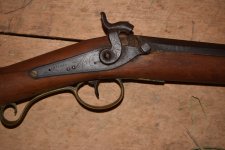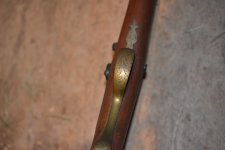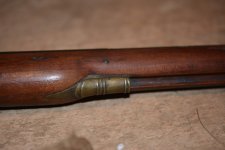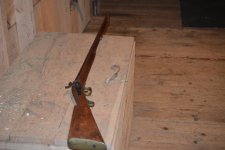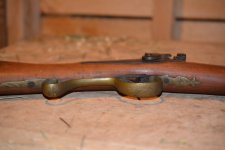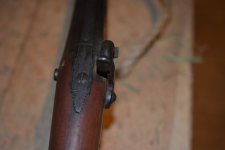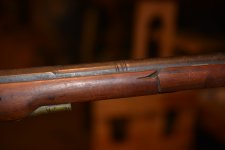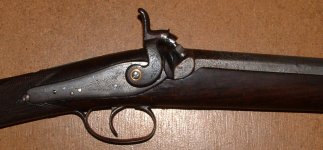Navigation
Install the app
How to install the app on iOS
Follow along with the video below to see how to install our site as a web app on your home screen.
Note: This feature may not be available in some browsers.
More options
You are using an out of date browser. It may not display this or other websites correctly.
You should upgrade or use an alternative browser.
You should upgrade or use an alternative browser.
✅ SOLVED .69 Caliber Musket Identification
- Thread starter coinman123
- Start date
coinman123
Silver Member
- Thread starter
- #3
Nice....Do you plan on shooting it ? Is it a replica ?
Thanks! It's authentic, with the wood in pretty rough shape with big gouges and a crack or two in the barrel stock. That just gives it character in my opinion though. I don't want to risk shooting it though, scared it would blow up on me. Any ideas on age?
Upvote
0
coinman123
Silver Member
- Thread starter
- #4
Also, Does it look to be converted from flintlock?
Upvote
0
ecmjamsit
Hero Member
- Dec 2, 2007
- 873
- 1,062
- Detector(s) used
- Whites Goldmaster GMT, GMII,Whites Sierra Super Trac, Ace250, Teknetics Gamma 6000, Whites Pinpointer,Garrett Pro Pointer II
- Primary Interest:
- Metal Detecting
Looks to be made by a J. Bishop I bet it is worth way more than you paid!
Collectors Firearms Archives - Home
Collectors Firearms Archives - Home
Upvote
0
coinman123
Silver Member
- Thread starter
- #6
Looks to be made by a J. Bishop I bet it is worth way more than you paid!
Collectors Firearms Archives - Home
Wow! Thanks for finding this, very cool! How old do you think this gun is?
Upvote
0
RTR
Gold Member
- Nov 21, 2017
- 8,180
- 32,481
- Detector(s) used
- Teknetics Liberator
Falcon MD-20
***********
Blue Bowl
Angus MacKirk sluice
Miller Table
- Primary Interest:
- All Treasure Hunting
I dont have any knowledge on flintlock or cap muskets.But I do know companies that sell reproduction kits will have the stock if & when you decide to replace it.A friend of mine bought & sold & put them together for 50 years.And some you cant tell the difference.Sure someone here with knowledge will chime in.
Upvote
0
coinman123
Silver Member
Upvote
0
- May 9, 2012
- 23,985
- 81,464
- Primary Interest:
- Other
Octagon to round barrel with wedding ring transition.
Is it smooth bore or rifled?
A Cocker Glasgow half stock rifle build has some similarities. The back action lock ,and the pineapple end shape on the trigger guards front. ( Pineapples had meaning back when.) Though similar ,still different. The snail,around the nipple ,even the shape of pineapple differ from your piece. But the engraved guard and design hint of a similar school..
Is it smooth bore or rifled?
A Cocker Glasgow half stock rifle build has some similarities. The back action lock ,and the pineapple end shape on the trigger guards front. ( Pineapples had meaning back when.) Though similar ,still different. The snail,around the nipple ,even the shape of pineapple differ from your piece. But the engraved guard and design hint of a similar school..
Upvote
0
BosnMate
Gold Member
- Sep 10, 2010
- 6,916
- 8,441
- Detector(s) used
- Whites MXT, Whites DFX, Whites 6000 Di Pro
- Primary Interest:
- Other
It's a back action cap lock, and no, it's not a conversion from flint. It was made that way. The back action is an invention a little later than the flint lock era. They are a fraction of a second faster than the traditional lock. I suspect, without seeing the muzzle of your gun, that is a "fowler." That just means it was built as a shotgun for hunting ducks etc.
Another thing, just because J. Bishop is on the lock, does not mean he made the gun, it generally means he made the lock. The gun maker generally had his name on the barrel, and if made in Europe, there would be proof marks on the barrel.
Are you positive it's .69 caliber? Did you measure the barrel?
Another thing, just because J. Bishop is on the lock, does not mean he made the gun, it generally means he made the lock. The gun maker generally had his name on the barrel, and if made in Europe, there would be proof marks on the barrel.
Are you positive it's .69 caliber? Did you measure the barrel?
Last edited:
Upvote
0
- Jun 8, 2006
- 6,281
- 8,900
- Detector(s) used
- Whites, Minelab, Tesoro, and custom machines
- Primary Interest:
- Metal Detecting
Nice piece!! You got a deal. Names on old guns can be misleading. We had a master gunsmith in our area that is quite famous locally. I got a chance to do some repair on one of his percussion rifles for a family member. It had his name on top of the barrel, but on the bottom was a company from Pennsylvania. The lock was from New York. I didn't show the relative what I had found.
Upvote
0
Nice piece. Something that old should never be fired. However, if you decide to fire it please give me all the information for me to take out life and disability insurance on you. No, they really are best left unfired.
Upvote
0
coinman123
Silver Member
- Thread starter
- #13
Upvote
0
BosnMate
Gold Member
- Sep 10, 2010
- 6,916
- 8,441
- Detector(s) used
- Whites MXT, Whites DFX, Whites 6000 Di Pro
- Primary Interest:
- Other
This might help people that aren't familiar with muzzle loading firearms.

This first picture is a flint lock. The hammer is down, directly under the flint is the "pan" for the priming powder. The "frizzen" is open. When priming powder is in the pan, the frizzen is closed. Note the spring that holds the frizzen either open or closed. That V shaped spring rules out any back action lock from having been a flint lock. Even if the lock was changed and a back action added later, the cut out inlet for the front of the flintlock would still be in the wood part of the stock.

This looks to me like a lock that has been converted from flint to cap lock. It looks like there are some remains of the frizzen, and there is evidence that there was a frizzen spring.

This is another side action lock. The location of the drum and nipple, and the hole in the forward part of the lock makes it possible that this could also be a conversion from flint to caplock. But inexpensive caplock rifles were also built using a drum and nipple, so sometimes it's hard to tell if it's a conversion or not.

This first picture is a flint lock. The hammer is down, directly under the flint is the "pan" for the priming powder. The "frizzen" is open. When priming powder is in the pan, the frizzen is closed. Note the spring that holds the frizzen either open or closed. That V shaped spring rules out any back action lock from having been a flint lock. Even if the lock was changed and a back action added later, the cut out inlet for the front of the flintlock would still be in the wood part of the stock.

This looks to me like a lock that has been converted from flint to cap lock. It looks like there are some remains of the frizzen, and there is evidence that there was a frizzen spring.

This is another side action lock. The location of the drum and nipple, and the hole in the forward part of the lock makes it possible that this could also be a conversion from flint to caplock. But inexpensive caplock rifles were also built using a drum and nipple, so sometimes it's hard to tell if it's a conversion or not.
Attachments
Last edited:
Upvote
0
NOLA_Ken
Gold Member
- Jan 4, 2011
- 5,214
- 4,179
- Detector(s) used
- several, mostly Garrett
- Primary Interest:
- All Treasure Hunting
That type of lock first came around in the 1830's as I remember, so no older than that. Muzzle loaders were pretty much obsolete by the 1870's so no newer than that, I would imagine more toward the earlier end of those dates
Upvote
0
coinman123
Silver Member
- Thread starter
- #17
That type of lock first came around in the 1830's as I remember, so no older than that. Muzzle loaders were pretty much obsolete by the 1870's so no newer than that, I would imagine more toward the earlier end of those dates
My guess is circa 1840, give or take 5 or 10 years either way, based on what I have heard from you guys and researched off of that information. How does that sound to you as an approximate manufacturing date? Thanks for all of the great info guys, going to try to make a display mount for the gun soon.
Last edited:
Upvote
0
Charlie P. (NY)
Gold Member
- Feb 3, 2006
- 13,017
- 17,163
- Detector(s) used
- Minelab Musketeer Advantage Pro w/8" & 10" DD coils/Fisher F75se(Upgraded to LTD2) w/11" DD, 6.5" concentric & 9.5" NEL Sharpshooter DD coils/Sunray FX-1 Probe & F-Point/Black Widows/Rattler headphone
- Primary Interest:
- Metal Detecting
I agree with BosnMate.
Back action lock and never a flintlock, shotgun rather than musket (it was intended for shot with that styling),
Here's another - Bishop made guns in London in the 1850's +/- (site won't let me copy the image). 16 bore (0.662")
ARMSLIST - For Sale: J. Bishop 16 ga Percussion Single Barrel Shotgun
Back action lock and never a flintlock, shotgun rather than musket (it was intended for shot with that styling),
Here's another - Bishop made guns in London in the 1850's +/- (site won't let me copy the image). 16 bore (0.662")
ARMSLIST - For Sale: J. Bishop 16 ga Percussion Single Barrel Shotgun
Upvote
0
coinman123
Silver Member
- Thread starter
- #19
Sorry for my ignorance, but how do you tell the difference between a muzzle loading shotgun and a musket?
Upvote
0
Charlie P. (NY)
Gold Member
- Feb 3, 2006
- 13,017
- 17,163
- Detector(s) used
- Minelab Musketeer Advantage Pro w/8" & 10" DD coils/Fisher F75se(Upgraded to LTD2) w/11" DD, 6.5" concentric & 9.5" NEL Sharpshooter DD coils/Sunray FX-1 Probe & F-Point/Black Widows/Rattler headphone
- Primary Interest:
- Metal Detecting
"Musket" is a military designation. Issued to troops, or militia, and usually with a bayonet fitting. Civilians used a fusil, firelock, gun - all mean the same thing. Sometimes "fowler", but that is the shooter not the gun.
Later (just before the Civil War era) they were rifled and called a "Rifled Musket".
Rifle, or rifled gun, would he the other firearm - more accurate and single projectile. Though a single round ball works great in muskets or smooth guns . . . out to 60 yards or a bit further.
Later (just before the Civil War era) they were rifled and called a "Rifled Musket".
Rifle, or rifled gun, would he the other firearm - more accurate and single projectile. Though a single round ball works great in muskets or smooth guns . . . out to 60 yards or a bit further.
Last edited:
Upvote
0
Top Member Reactions
-
 3348
3348 -
 1893
1893 -
 1849
1849 -
 1148
1148 -
 1096
1096 -
 864
864 -
 857
857 -
 839
839 -
 828
828 -
 748
748 -
 735
735 -
 548
548 -
 537
537 -
 503
503 -
 441
441 -
 428
428 -
E
414
-
 399
399 -
 393
393 -
 391
391
Users who are viewing this thread
Total: 2 (members: 0, guests: 2)
